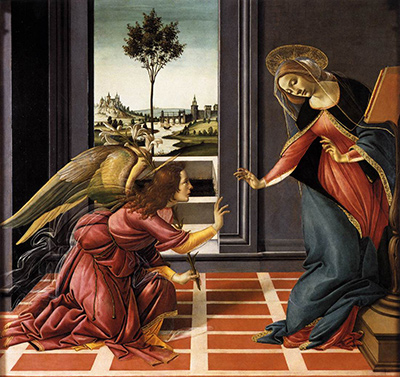The Annuciation, also known as Cestello Annuciation, is a painting by Sandro Botticelli from 1489. As one of the most respected Renaissance painters, Botticelli earned his reputation with his use of form and attention to detail.
The Annuciation is the Christian Biblical scene where the angel Gabriel tells the Virgin Mary that she will carry God's child.
In the left of the painting Gabriel prostates himself in front of Mary, who moves away from him while reaching toward him at the same time.
This conflict seems human in a way not seen in many paintings of the scene; perhaps Mary would show some joy, but the shock would be a huge emotional factor too. Botticelli presents this in a faithful way, still showing the importance of the scene without taking away its human factor.
This is not the only time that Botticelli painted the Annuciation. He also completed a painting on the same thing twice around the same time period. This version is housed nearest Botticelli's home in Italy; it is currently housed in the Uffizi Gallery of Florence, where it has stood for over one hundred years. Another highly significant work was Leonardo da Vinci's Annunciation, whilst Sandro Botticelli also painted Annunciation and Annunciation (1485-92).
When the painting was originally commissioned it was intended to decorate a local monastery, Cestello, which exists to this day under the name of Santa Maria Maddalena de'Pazzi. However its importance in art history means it is better housed in a gallery.
During Botticelli's time oil paints were not yet available; instead he used tempera, which is a pigment trapped in a base that was often made of egg (it is also known as egg tempera).
This paint was very fast-drying and it took considerable skill to use it the way Botticelli did. Artists often mixed egg tempera with pleasing fragrances to avoid the pungent smell that stayed for a while after finishing the painting; this was to give the usually religious viewers a more pleasant experience of the scenes as a whole.
Botticelli used details around the subjects of the paintings to draw more depth into the scene. In the case of the Cestello Annunciation he painted a window past the angel Gabriel and the Virgin Mary, looking out into the distance over trees and hills.
It is possible this is supposed to symbolise the eternity of the moment for Christianity. Details such as these bring layers to a painting already filled with sublime detail, and it is for reasons such as these that Botticelli remains a respected artist of his time.




